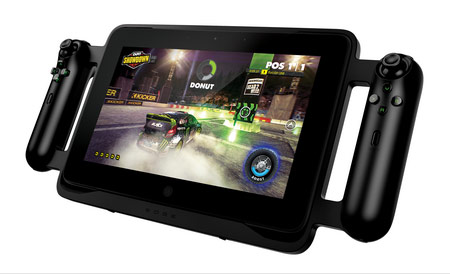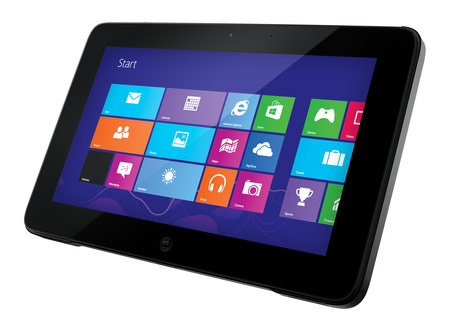Razer Edge: Hands-On With The x86 Gaming Tablet At CES 2013
Razer continued developing Project Fiona, which we saw at E3 last year, and it's turning into the Edge. We spent some time with it at CES, and are ready with some first impressions, along with a report on the hardware and accessories Razer plans to sell.
Razer's Edge: Project Fiona Becomes A Product
The Project Fiona gaming tablet concept generated a lot of interest at last year's E3. By now, many of you have seen how much attention its resulting product, the Edge, garnered at CES 2013.
It's easy to love the Edge at first glance. It's different, after all. But after that initial impact wears off, I have to admit that I didn't understand why a Windows 8-based tablet with discrete mobile graphics could create so much buzz.
Don't get me wrong; this is the closest thing to an x86 tablet running Windows 8 that I'd want to buy. I like the flexibility to install whatever I want and I'm a gamer, so what's not to love? And although Nvidia's Shield looks interesting, it's an Android-based handheld at the end of the day, and I'm less interested in that platform, even with the Steam tie-in.
The question becomes: is it better to game on a device streaming H.264-encoded content from a high-end PC (potentially yielding gobs of battery life) or a piece of hardware rendering natively? We'll be able to answer that once we get both the Edge and the Shield into our lab, and set up a controlled comparison. For the time being, we're limited to my experiences with the Edge and Angelini's with the Shield.
The basic Edge features a 10.1", 1366x768, 10-point capacitive touchscreen, a mobile Core i5-3317U processor with a 1.7 GHz base and 2.6 GHz maximum Turbo Boost clock rate, 4 GB of DDR3 memory, a 64 GB SSD, and a GeForce GT 640M LE GPU for $1,000. The Edge Pro shares the same size and weight as the base model, but upgrades to a Core i7-3517U (at 1.9 GHz, scaling up to 3 GHz), 8 GB of DDR3 memory, and a 128 or 256 GB SSD.
Frankly, I doubt the Core i7 will make much of a difference in games. After all, that particular model is still a dual-core chip with Hyper-Threading technology. The larger SSD is probably the biggest upgrade, since it makes room for more gaming and video content. You'll pay a premium for higher-end parts though, to the tune of at least $1,300.
Those are clearly impressive specs for a tablet. But none of them are particularly advanced. The GPU amounts to a desktop-class GeForce GT 640 with a much lower clock rate (down from 900 MHz to 500). The CPU is necessarily modest in order to fit within a 17 W TDP. And you pay quite a bit for the combination of parts Razer is using.
Get Tom's Hardware's best news and in-depth reviews, straight to your inbox.
Of course, this fails to recognize the challenge presented by fitting a 32 W graphics processor, a 17 W host processor, and a complete platform into a handheld that isn't inconvenient to carry or outright dismal when it comes to battery life. Surely it wasn't easy; Asus was showing off its Transformer Book for a while with similar specifications, but that thing seems to have vanished. So there's clearly lots of engineering involved.
Current page: Razer's Edge: Project Fiona Becomes A Product
Next Page Razer's Edge: The Tablet And AccessoriesDon Woligroski was a former senior hardware editor for Tom's Hardware. He has covered a wide range of PC hardware topics, including CPUs, GPUs, system building, and emerging technologies.
-
mayankleoboy1 ReplyBut as with most innovative ideas, I'm more excited about what the Edge might become in a couple of generations as Intel and Nvidia further improve performance at lower power ceilings.
Precisely. And this is why Razer Edge is going to fail on release. -
roninx I'm a gamer, and I do a lot of business travel, so the Edge appeals to me for use on airline flights. My only concerns are about the battery life and whether its comfortable to hold with the game controller for extended periods of time.Reply
I wonder whether someone could build a device that was only a 7" or 10" screen attached to a game controller with HDMI and USB connections. Combine that with a gaming laptop and a huge battery that could fit in a laptop case under the seat in front of you. Then you would get both light weight and extending gaming time. Obviously, you're not going to fit an M18x down there, but something like a W110ER with a 200 watt-hour battery could work nicely.
-
DarkSable Hmm. I'd never, never buy one of these, but I sincerely hope it succeeds.Reply
Why? Simple. If it does, then there will be more people wanting to play split screen games on the windows OS. That means that there will be more of said games made, which means I win. -
I dont understand. Is the batterylife extended with 2 hours gaming with the additional batterypack, or is it extended with one hour of gaming?Reply
Both batterys are the same size, but all reports about batterylife says different things.
Usually its 1-2hours of gaming with 6-8 hours non gaming tablet use.
But does this mean 2-4 hours of gaming and 12-14 hours of normal use with the extended battery pack, or does it mean 30 minutes to one hour of gaming and 3-4 hours of normal use without the extra battery?
I also want to know how easy it is to pause the game, pop out the tablet from the mobile controller dock, change battery in the dock, and pop the tablet back.
If this is easy to do, and if the batterylife of one battery is 1-2 hours of gaming and 6-8 normal use, i will not see batterylife as a problem. I will just buy some extra batteries for 5-10 hours of gaming and 30 - 40 hours of tablet use. But i will skip this machine if batterylife of one battery is 30min -1 hour of gaming, and instead hope others will buy and wait for the second generation razer edge. -
sna I like it .. and all people who say negative things about it , like Battery life , and wait for next CPU .. wake UPReply
this thing STILL HAS HD4000 , and you CAN shutdown the 640M GPU , and use the HD4000 for battery life like any tablet in the market.
and when there is a POWER source near you ... plug it and use the 640M , like in Trains , Planes , etc ...
but I tell you somthing , some people who "want it" and cat have it , are .... -
cleeve Gabriel TardeI dont understand. Is the batterylife extended with 2 hours gaming with the additional batterypack, or is it extended with one hour of gaming?Reply
Depends on the game.
But demanding games will be 1 hour of battery life out of the package, and 2 hours with the extended battery.
-
cknobman CleeveDepends on the game. But demanding games will be 1 hour of battery life out of the package, and 2 hours with the extended battery.Reply
Sorry but that is just not going to cut it especially for the mobile gaming market (which what this appears to be targeting).
This is a great idea but technology and pricing just are not quite there yet. This needs to be capable of gaming on the standard batter for ~3hours and they need to be able to package the thing with the gaming dock for $1000 -
cleeve cknobmanThis is a great idea but technology and pricing just are not quite there yet. This needs to be capable of gaming on the standard batter for ~3hours and they need to be able to package the thing with the gaming dock for $1000Reply
Sounds like our conclusion. :)
-
lordravage "the Edge drove Uncharted at 1920x1080 with no performance issues."Reply
Did I read correctly that you were playing Uncharted on a PC?


